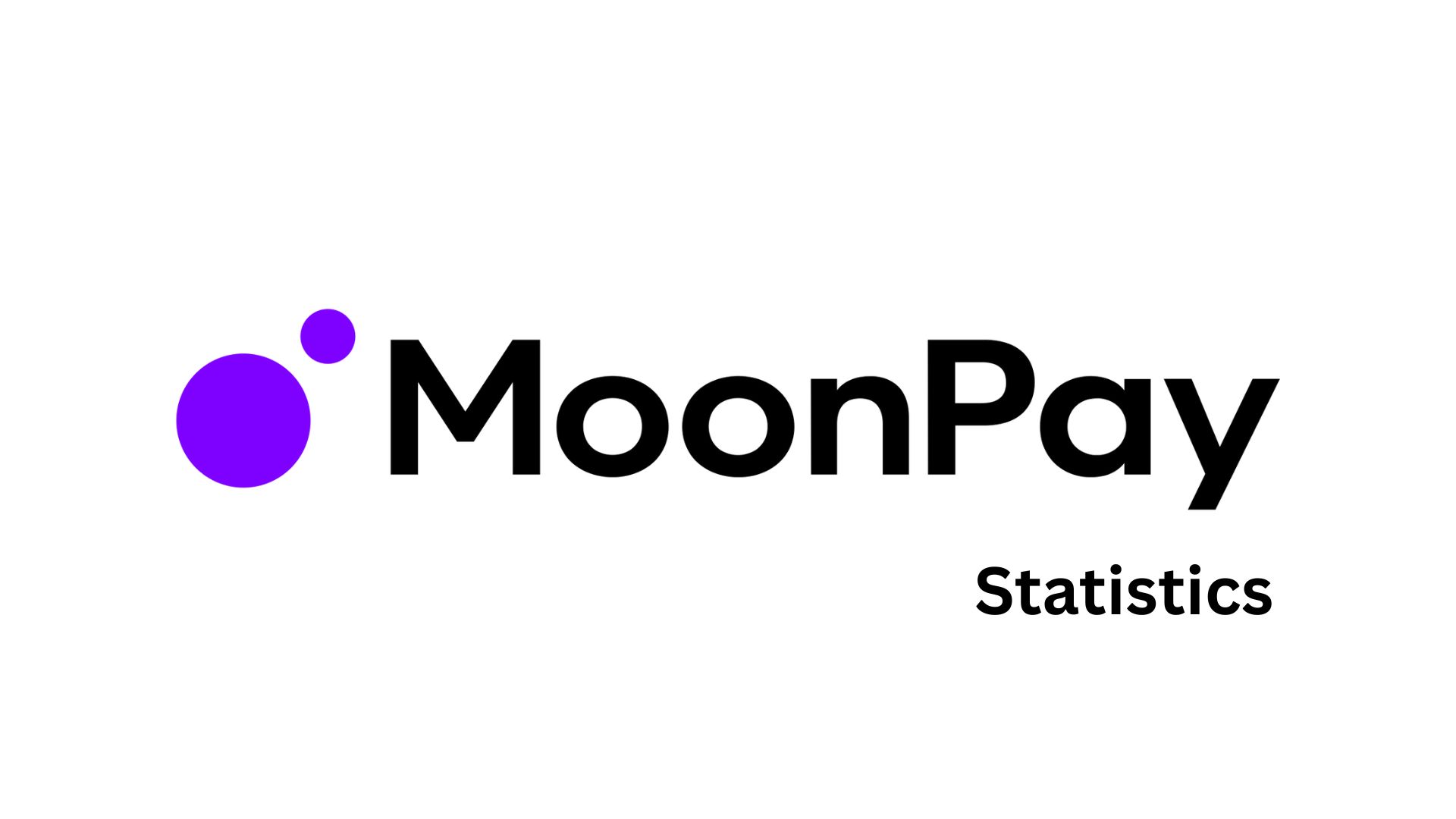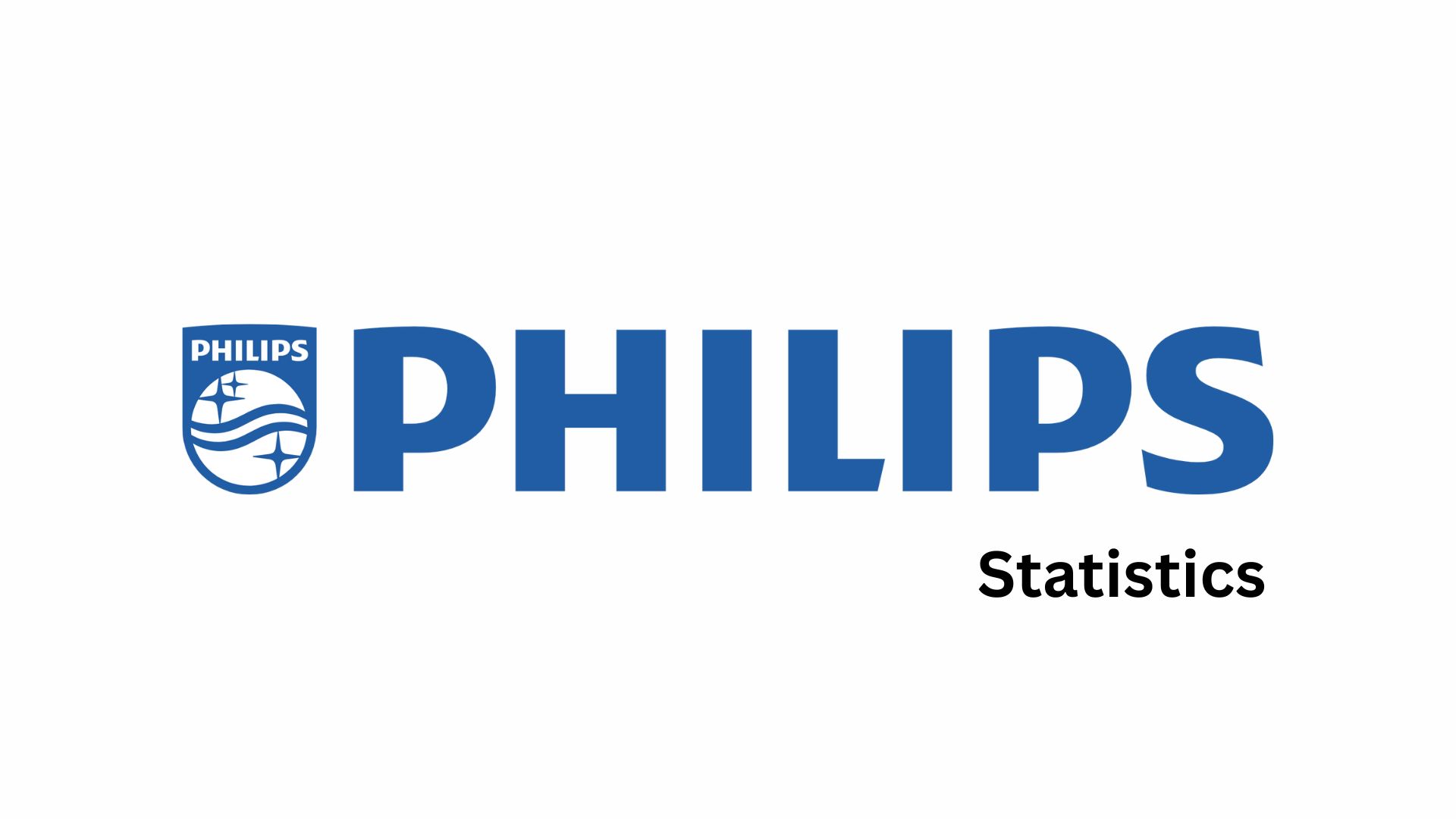Sennheiser Statistics By Revenue, Employees and Facts (2025)
Updated · Nov 10, 2025

Table of Contents
- Introduction
- Editor’s Choices
- History of Sennheiser
- Fun Facts About
- Sennheiser Turnover Development
- Sennheiser Turnover By Region
- Sennheiser Research and Development
- Sennheiser Patents
- Sennheiser Number of Employees
- Development of The Number Of Employees
- Employees By Region
- Workforce Diversity And Demographics At Sennheiser Group
- Sennheiser’s Quality, Safety, And Compliance Framework
- Sennheiser Momentum Sport Headphones
- Best Sennheiser Headphones of 2024
- Conclusion
Introduction
Sennheiser Statistics: Founded in 1945, Sennheiser has long been synonymous with premium sound, professional audio solutions, and cutting-edge innovation. In 2024, the company reaffirmed its leadership in the global audio industry with a total turnover of €492.3 million, a robust presence across EMEA, the Americas, and APAC, and continued investment in R&D worth €49 million.
The following synoptic Sennheiser statistics reveal the key facts and percentages regarding Sennheiser’s size, sales, personnel, and investments for the fiscal year 2024 — the numbers that most people associate with “Sennheiser 2025” media coverage.
Editor’s Choices
- The figure for Sennheiser’s total turnover in fiscal year 2024 was €492.3 million; this indicates a 6.6% decline with respect to the previous year.
- The EMEA area was the most robust market with a revenue of €232.1 million, which also included €78.8 million from Germany.
- The total revenue from the Americas was €150.5 million, whilst the income from the APAC area was €109.7 million.
- To promote the future applications of professional audio technologies, the company allocated about €49 million for research and development activities in the year 2024.
- Sennheiser applied for 22 new patents in 2024 and now counts 235 patent families upholding the company with 182 patents granted.
- On the last day of 2024, Sennheiser had 2,196 workers worldwide, amongst whom were 26 apprentices.
- The trend in the number indicates a rebound of the workforce since 2021, the count rising from 1,969 in 2021 to 2,196 in 2024.
- The EMEA has 1,825 personnel, with Germany having the largest share of 1,398; APAC has 229, and the Americas have 142 employees.
- The male-female ratio is 61% male, 39% female, and 19% female in leadership positions.
- A total of about 419 factory workers (19%) are in production, mainly located in Germany (306) and Romania (113).
- Co-hort representation is as follows: 13% Baby Boomers, 36% Generation X, 45% Generation Y, and 6% Generation Z.
- The diverse workforce of Sennheiser comprises 54 nationalities worldwide, with 33 nationalities represented at the company’s headquarters in Wennebostel.
History of Sennheiser
- 1945: Fritz Sennheiser founded Laboratorium Wennebostel (Labor W) near Hanover; the first products were measuring instruments.
- 1946: The company built its first microphone for Siemens, the DM 1; in 1947 it launched its own DM 2.
- 1953: The MD 21 dynamic microphone entered production and became a broadcast standard.
- 1956: The MD 82 was introduced as a shotgun microphone, among the first of its type available commercially.
- 1957: “Microport” wireless microphone systems were introduced for television production.
- 1958: Labor W was renamed Sennheiser electronic.
- 1960: The MD 421 cardioid dynamic microphone was launched and later became an industry standard.
- 1963: U.S. distribution was established as Sennheiser Electronics Corp.
- 1968: The HD 414, the world’s first open-back headphone, was released; it went on to be a best-selling full-size headphone.
- 1971: The MD 441 microphone was introduced and quickly recognized as a studio classic.
- 1973: The company adopted a limited partnership structure (KG).
- 1980: Entry into aviation headsets began with supply to Lufthansa.
- 1982: Modern wireless microphone production started; Fritz Sennheiser transferred management to his son Jörg.
- 1987: An Academy Scientific and Engineering Award recognized the MKH 816 shotgun microphone.
- 1990: Tullamore, Ireland manufacturing site opened for transducer production.
- 1991: Acquisition of Georg Neumann GmbH brought the iconic studio microphone brand into the group.
- 1999: Evolution Wireless series reached market success and became a global stage staple.
- 2000: The MKH 800 studio condenser arrived for high-resolution digital formats; the Albuquerque, New Mexico plant opened.
- 2003: A joint venture created Sennheiser Communications A/S for headsets; this ended in 2020 with the gaming and enterprise lines moving to EPOS under Demant.
- 2005: Speaker maker Klein + Hummel was acquired to expand the monitor portfolio.
- 2008–2010: Daniel and Andreas Sennheiser joined the company and later became co-CEOs in 2013.
- 2015: The HE 1 succeeded the legendary Orpheus electrostatic headphone; the Innovation Campus in Wennebostel opened.
- 2017–2018: Digital 6000 wireless and TeamConnect Ceiling with dynamic beamforming were introduced; “20 Years of Evolution” marked the EW series success.
- 2019: A majority stake in Dear Reality strengthened spatial audio software capabilities.
- 2021: The consumer audio division sale to Sonova was announced.
- 2022: The Sonova acquisition closed, granting an exclusive, perpetual license for the Sennheiser brand in consumer audio.
- 2023: The Spectera wideband, bidirectional digital wireless ecosystem was unveiled.
- 2024: AMBEO collaborations extended to automotive, including speakerless in-car audio with Continental and work with CUPRA Tavascan.
- 2025: The company celebrated its 80th anniversary; management changes were announced with Daniel Sennheiser moving to Chairman while Andreas Sennheiser continued as CEO.
Fun Facts About
- Founded in 1945 as Laboratorium Wennebostel in a farmhouse near Hanover, later renamed Sennheiser electronic.
- Headquartered in Wedemark, Germany, with factory visits offered at the campus.
- Still a family-owned company, now led by third-generation co-CEOs Daniel and Andreas Sennheiser.
- The company celebrates its 80th anniversary in 2025.
- The HD 414 introduced in 1968 is widely credited as the world’s first open-back headphone and sold over 10 million units.
- Sennheiser received an Academy Award (Oscar) in 1987 for the MKH 816 shotgun microphone and later received an Emmy for advances in RF wireless technology.
- The group acquired Georg Neumann GmbH in 1991, adding one of the most respected studio-microphone brands to its portfolio.
- The consumer audio division was sold to Sonova in 2021, with closing in March 2022, and Sonova holds a perpetual brand license for Sennheiser in consumer markets.
- Professional-audio operations recorded €527.2 million revenue in fiscal 2023, up 12.7% year on year.
- Group sales reported for 2024 were €492.3 million, reflecting a 6.6% decline versus the prior year.
- The company reported 2,196 employees worldwide as of 31-12-2024.
- Regional revenues in 2024 were €232.1m in EMEA, €150.5m in the Americas, and €109.7m in APAC, with €78.8m in Germany.
- Historic microphones such as the MD 421 and MD 21 became reporting and studio standards and remain iconic in broadcast history.
- Sennheiser’s leadership emphasizes long-term R&D cycles and sustained investment, which is frequently cited as a driver of enduring product innovation.
Sennheiser Turnover Development
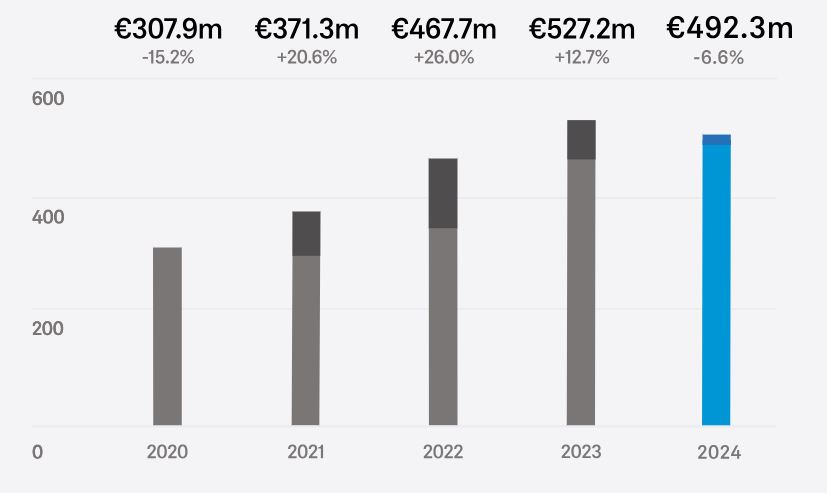
(Source: sennheiser.com)
- The Sennheiser Group, renowned for its professional audio products, declared a total revenue of €492.3 million during the fiscal year 2024.
- This signifies a tiny decline of 6.6%, or €34.9 million, relative to last year.
- The drop comes after three years in a row of increased revenue, thus moderately slowing down the company’s financial performance, albeit it still has the professional audio sector as its main focus.
Sennheiser Turnover By Region
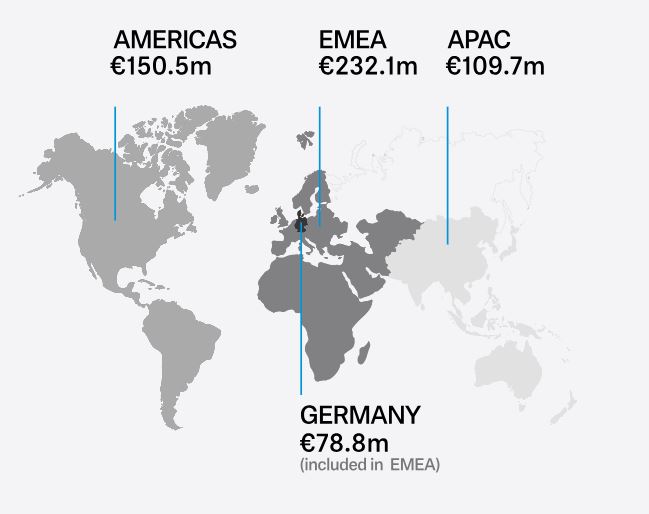
(Source: sennheiser.com)
- The Sennheiser Group reported the highest revenue in 2024 from the EMEA region, which generated €232.1 million. Of this, Germany, the company’s home market, accounted for €78.8 million.
- The Asia-Pacific (APAC) region also performed well, generating €109.7 million.
- On the other hand, the Americas region had a collective revenue of €150.5 million for the fiscal year.
- Such results indicate Sennheiser’s well-balanced global positioning and not only retention but also an upsurge across all essential markets.
Sennheiser Research and Development

(Source: sennheiser.com)
- The Sennheiser Group allocated €49 million to its 2024 research and development budget, focusing on new technologies in the audio field, as well as the development and improvement of existing products.
- The investment is the company’s venture into improving production quality and advancing technology in the sound industry through product innovation and market leadership.
Sennheiser Patents
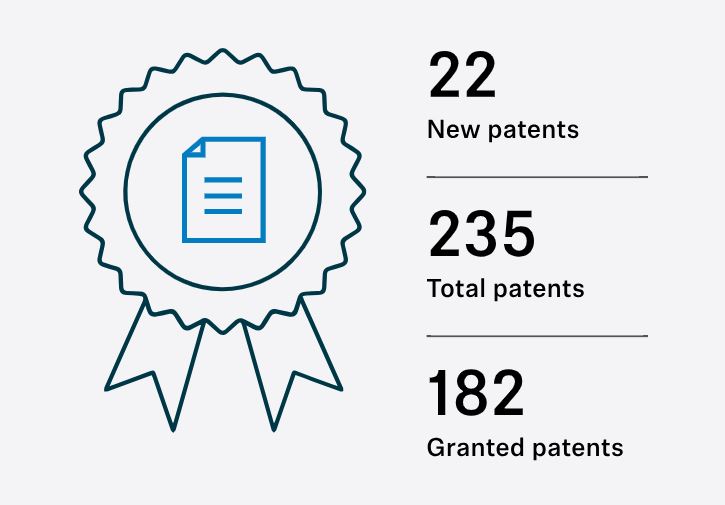
(Source: sennheiser.com)
- The Sennheiser Group has notably increased its intellectual property portfolio in 2024 with the registration of 22 new patents.
- The total number of patent families owned by the company now amounts to 235, of which 182 have been officially granted.
- This is an impressive indicator of Sennheiser’s continuous dedication to the field’s innovation and technology development.
Sennheiser Number of Employees
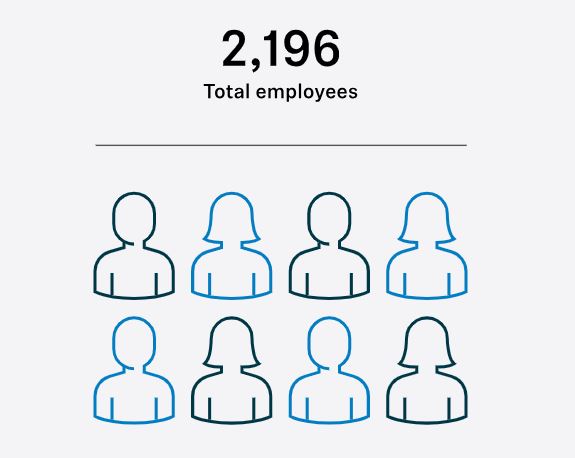
(Source: sennheiser.com)
- Sennheiser’s global workforce was comprised of 2,196 employees on December 31, 2024, the same number as the previous year.
- The sound experiences that the company offers to its customers are produced by the combined efforts of all its employees.
- Furthermore, the firm provided its apprenticeship program with training for 26 workers who were part of the international Sennheiser family, thus participating in the company’s mission and acquiring valuable knowledge and experience in the audio sector.
Development of The Number Of Employees
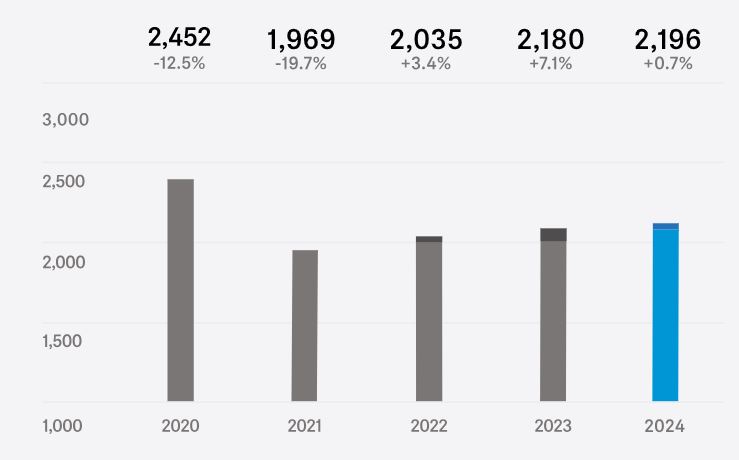
(Source: sennheiser.com)
- The number of employees in the company varied greatly from year to year during the period from 2020 to 2024.
- The employee number in 2020 was 2,452, and the reduction in workforce in the following year was 12.5%, which lowered the count to 1,969.
- Recovery was evident in the subsequent year, as the workforce expanded by 3.4%, resulting in a total of 2,035 employees by 2022.
- The upward trend of 2023 continued with 7.1% raising the total to 2,180. The company had already reached a stable workforce in 2024 with an increase of only 0.7%, which resulted in 2,196 employees.
- The summarized data indicate a transition from the downsizing phase through gradual recovery to stabilization.
Employees By Region

(Source: sennheiser.com)
- The Sennheiser Group has a worldwide presence, relying on 25 sales subsidiaries and 55 sales partners.
- The total number of employees across the planet is 2,196, and the majority, approximately 1,825, are located in the EMEA region.
- Among these, 1,398 are in Germany, which emphasizes the significance of the country as a central point for the company’s activities.
- Moreover, the APAC region has 229 employees, while the Americas have 142.
- This distribution not only illustrates the firm’s strong European base but also acknowledges the company’s global footprint.
Workforce Diversity And Demographics At Sennheiser Group
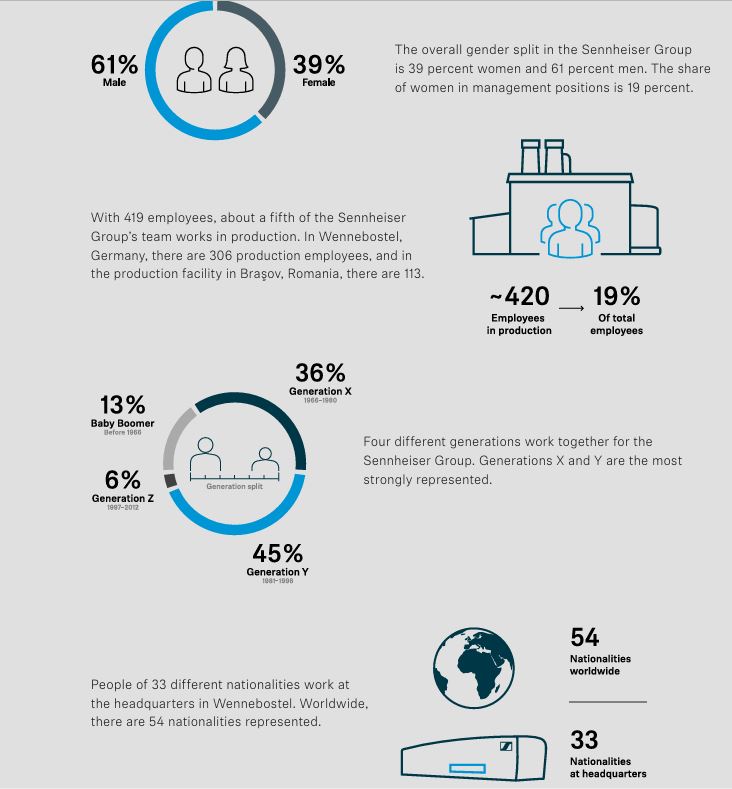
(Source: sennheiser.com)
- The Sennheiser Group represents a variety of employees and a workforce that is a mix of different ages, genders, and nationalities.
- In terms of gender, the ratio of male to female employees is 61% to 39% with women occupying 19% of the management positions.
- Out of the company’s total staff, approximately 419 employees work in production, which is about one-fifth of the entire workforce.
- Among them, 306 work in Wennebostel, Germany, while 113 are based in Brașov, Romania.
- A look at the generational distribution shows that the company has employees from four generations working together.
- Generation X (1966-1980) comprises 36% of the workforce, while Generation Y (1981-1996) is the largest group with a 45% share.
- Baby Boomers account for 13% and Generation Z (1997-2012) makes up 6%.
- One of the main characteristics of the Sennheiser brand is cultural diversity.
- It is reported that the headquarters in Wennebostel has employees from 33 different nationalities, whereas the company’s total global workforce includes individuals from 54 nationalities.
- This is a clear indication of the company’s policy to create an inclusive and globally connected workplace.
Sennheiser’s Quality, Safety, And Compliance Framework
- Although the data presented is mostly indirect and very limited, it identifies some critical facts based on Sennheiser’s quality, safety, and compliance that are process-based and time-specific.
- The most important statistic is the last review date of January 9, 2024, which points to Sennheiser’s regular updating of its compliance and quality management systems as a way of staying in sync with global standards.
- The standard ISO 9001 is an internationally recognized company operating standard that Sennheiser works under, giving continuous quality management and product safety as a guarantee.
- The whole process of quality assurance at Sennheiser is subjected to regular auditing, both internally and externally.
- The audits cover product safety, regulatory compliance, and conformity assessments.
- Importantly, all audit results, test reports, certificates, and technical documentation are retained for a ten-year period, which provides long-term traceability and accountability.
- Sennheiser also follows very strict standards for environmental and materials conformity, particularly the RoHS Directive (Restriction of Hazardous Substances) and the REACH Regulation (Registration, Evaluation, Authorisation, and Restriction of Chemicals).
- These control the presence of hazardous substances in its electrical and electronic equipment, thus providing double protection for consumers and the environment.
- Sennheiser’s product development process is designed based on three major pillars: compliance planning, compliance testing, and market access/conformity assessment.
- Testing is done both in external certified laboratories and in Sennheiser’s own cutting-edge internal laboratory, which highlights the accuracy and consistency of the process.
Sennheiser Momentum Sport Headphones
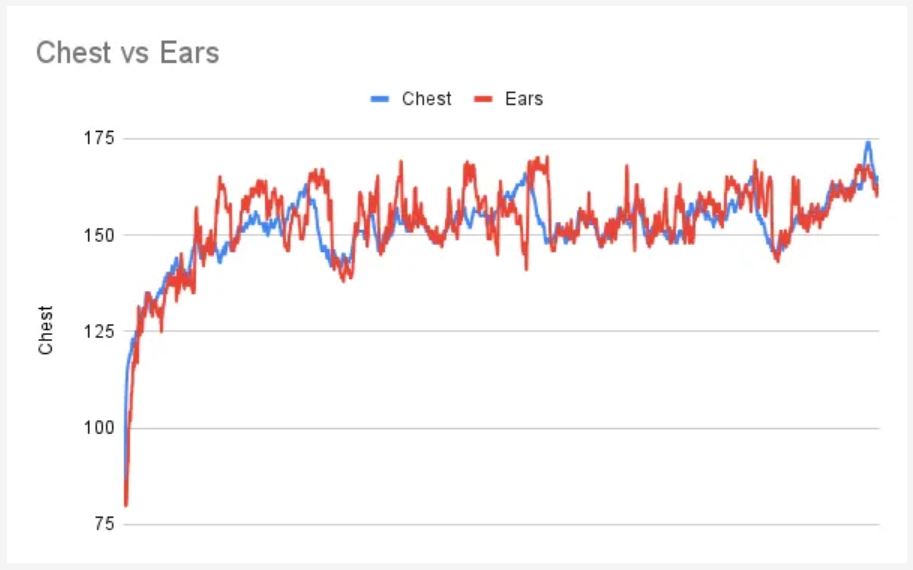
(Source: zulusierra.co)
- A practical evaluation of the Sennheiser Momentum Sport headphones showed that their biometric tracking functions were not effective at all.
- An in-built heart rate (HR) sensor was able to achieve a correlation of 0.82 when compared to a professional chest strap monitor, indicating good accuracy, but still some inconsistency.
- A running experiment showed that a CORE sensor monitored a person’s body temperature going up from 37.06 °C to 38.43 °C, while the Momentum Sport’s temperature readings remained almost unchanged at around 37 °C for the first 15 minutes, signalling an unreliable temperature measuring system.
- Consequently, the reviewer, upon seeing such discrepancies, made a call that the product’s fitness-tracking features had actually not worked as promised.
- He finally returned the headphones, saying that it was not worth paying £280 for a device that does not give accurate biometric data.
Best Sennheiser Headphones of 2024
Sennheiser continues to set the standard for audio quality that pleases both purists and casual listeners. The Headphones Lineup for 2024 from the brand shows creativity, cosiness, and accuracy in different price ranges and user groups.
#1. Sennheiser HD 800 S
- The Sennheiser HD 800 S remains the premier option for professional audiophiles seeking an exceptional listening experience.
- Even though these headphones have a very high price and need an amplifier in order to be fully utilized, their open-back design creates a remarkably big and natural-sounding area, perfect for enjoying listening at high fidelity.
- Customers give the HD 800 S very high marks for accurately separating instruments from one another and maintaining a neutral, well-balanced sound profile that remains clear across all frequencies.
- The low bass response, while still detectable, is milder than that of headphones with closed backs, and a slight bass boost keeps things warm without overpowering the voices or playing the instruments too loudly.
- They are made with top-quality materials and therefore are strong enough to last long and provide comfortable listening sessions; however, users with smaller heads may think the ear cups are a bit too big for them.
#2. Sennheiser HD 490 PRO
- If you are a listener who longs for the professional performance but at a more reasonable price, then the Sennheiser HD 490 PRO is just the right thing for you, as it gives one the perfect mix of quality and value.
- These open-back headphones are lighter than the HD 800 S and don’t need an amp, hence they will work with various sound devices.
- They give a bit more bass while still having a neutral and detailed sound character, thus highlighting the kick drums and vocals but not the treble sharpness too much.
- By providing two pairs of ear pads, the user can gently alter the sound profile to their liking of the user.
- Not only that, but the ear cups can also be rotated flat to allow for easy placement on the neck; this is a very uncommon feature in the case of open-back headphones.
- The Plus version comes with an additional cable and extra padding for the headband, making the overall experience more comfortable and giving the user more choices.
- So, the HD 490 PRO is versatile, comfortable, and precise in sound quality at the level of the studio, thus making it perfect for listening critically or just for daily use.
#3. Sennheiser HD 560S
- The Sennheiser HD 560S can be said to be a cheap and cheerful option for audiophiles.
- It does come with fewer extras and somewhat less uniformity in frequency response than the HD 490 PRO, but still makes up for it by being so open-backed and neutral in tonal balance.
- The bright, detailed sound signature brings out the vocals and the sounds from cymbals; therefore, the clarity is commendable.
- Though the deep bass is not that of the HD 560S is a comfort for the wearer owing to its light weight, detachable cable of a great length, and good stability.
- These are the qualities that make it suitable for long listening sessions. On the other hand, the high treble might cause a bit of ear fatigue to those who are sensitive to sound.
- Still, the HD 560S produces a sound that is very true to its source, which is a very attractive feature for people who love hearing every detail and do not mind the absence of heavy bass.
#4. Sennheiser MOMENTUM 4 Wireless
- The Sennheiser MOMENTUM 4 Wireless headphones are the best choice for those seeking ease of use and modern features, as they offer supreme wireless connection quality for daily use.
- The headphones feature adaptive ANC (active noise cancellation), a built-in mic, and support multiple devices simultaneously, allowing for quick switching between your mobile device and computer.
- The sound signature is bass-oriented, which is perfect for genres like EDM and hip-hop. At the same time, the user can tweak the sound via the app’s graphical equaliser and presets.
- The battery life is remarkable, lasting up to 62 hours per day, making it one of the best in its category. In case the battery drains, you can still use them wired, and the USB connection will give full control.
- As far as the smallest available to the Sennheiser MOMENTUM True Wireless 4 earbuds go, they still present the same features—ANC, multi-device pairing, and dust and water resistance with an IP54 rating—in a tiny design.
- Their battery lasts shorter than that of the over-ear model, but they still deliver Sennheiser’s characteristic sound quality.
Conclusion
Sennheiser Statistics: The year 2024 is expected to be a bright season for Sennheiser, as its performance has been consistently validated, cementing the brand as a leader in the global professional audio market. With a turnover of €492.3 million, strong EMEA presence, and nearly €49 million investment in R&D, the company has been and will continue to be the one that brings fresh ideas and sound characteristics to the market.
Its diverse and inclusive workforce, spanning 54 nationalities, reflects Sennheiser’s global commitment to quality and collaboration.
FAQ.
A total turnover of €492.3 million was reported by Sennheiser for the fiscal year 2024, which marked a decline of 6.6% compared to the previous fiscal year.
With €232.1 million, the EMEA region was first, which included €78.8 million from Germany, and then the Americas (€150.5 million) and APAC (€109.7 million) regions.
An estimated €49 million was Sennheiser’s investment in research and development for the professional audio technology sector to foster innovation.
Sennheiser’s global workforce on December 31, 2024, consisted of 2,196 individuals, comprised of 26 apprentices, and spread across 25 subsidiaries and 55 partners.
The company’s top model headphones for 2024 include the HD 800 S, HD 490 PRO, HD 560S, and MOMENTUM 4 Wireless. These models are designed for different audiences, from audiophile-grade sound to modern wireless convenience.

I hold an MBA in Finance and Marketing, bringing a unique blend of business acumen and creative communication skills. With experience as a content in crafting statistical and research-backed content across multiple domains, including education, technology, product reviews, and company website analytics, I specialize in producing engaging, informative, and SEO-optimized content tailored to diverse audiences. My work bridges technical accuracy with compelling storytelling, helping brands educate, inform, and connect with their target markets.



